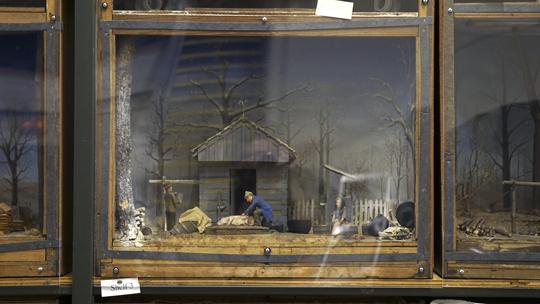A wealth of history and oddity: the SIU Museum archives

University Museum director Dona Bachman discusses the restoration of Aaron Bohrod’s painting, “Dreams,” on Thursday, Aug. 25, 2016, in the University Museum’s archives warehouse. (Andy Phillippe | @andyphillippede)
August 29, 2016
Of 70,000 artifacts kept by the SIU University Museum, Susannah Munson, curator of anthropology for the museum and its archives, keeps a list of the ones she finds most unusual.
Munson’s list includes a leopard skin acquired in the 1950s, a New Guinea costume made of mud and grass, and jewelry once given as a gift to the wife of Henry Kissinger.
“I’ve been here for eight or so years and I still run across things I’ve never seen before,” Munson said. “I walked past a sculpture one day and thought, ‘That’s really cool, is that new?’ and I looked it up and we got it in 1982.”
Advertisement
Dona Bachman, director of the University Museum and the Museum Studies program, said the museum aims “to preserve things forever.”
“That’s our vision — it’s not possible, but we make all the efforts,” Bachman said.

Bachman said the museum archives are closed to the public and mostly used for storage, research and specialized class groups that arrange to come study the artifacts.
These classes include those from the theater department to observe the expansive clothing collection, the geology students research of the rocks and minerals housed there and the metalworking classes inspect the various sculptures residing within the archive walls.
But Bachman said she still feels the archives are not utilized to their full potential. The location of the archives can also be inconvenient, she said.
Though the museum itself is located in Faner Hall, the archived artifacts are housed off McLafferty Road more than a mile from main campus.
“It could be used so much better, but part of it is location, and part of it’s time,” Bachman said. “It’s hard to convince professors to work this into their schedule and try to transport their classes out here.”
Advertisement*
Nonetheless, Munson said the archives are beneficial to an array of SIU departments.
“We have things related to aviation, engineering, forestry — these departments might not think we have something of interest to them but we have a little bit of everything,” she said.

Walking through the storage rooms of the archives makes that abundantly clear.
In one climate controlled room, the grass, wood and mud constructed artifacts from New Guinea in the late 1800s are situated, and in another, set models from a former SIU theater department set designer can be found.
Rows upon rows of artifacts line the main storage area with pieces from all over the world sitting on shelves waiting, to be used for research or classwork. Artifacts from SIU also abound.
“There’s the old Grey Dawg,” Munson said, gesturing toward the now-idle mascot suit. “Actually, sometimes when I’m walking through here and the lights are off it’s a little creepy — he’s got his arms up like he’s going to attack you.”
The archives can be a pretty spooky place, she said. The only lights that are typically on in the storage rooms are the ones directly by where people are working on projects. This helps to reduce light damage to the objects.
“I’ve totally walked through here when it’s mostly dark and thought, ‘This is how horror movies start,’” Munson said.
“As an archive employee, even things that at first appear weird quickly become normal,” said Kyle Clymore, assistant curator of collections with the University Museum. “The more you work with a collection the more artifacts that have a ‘spooky’ aesthetic or a maybe a strange story become commonplace.”
One of Clymore’s favorite collections is made up of more than 80 Japanese sword guards, or “tsuba.”
“They have really beautiful sculpted imagery that was probably used by actual Samurai at one point,” he said. “That collection was probably the first one that I fell in love with as an archive worker.”
Another climate controlled room shelters valuable artwork, such as paintings and prints done by Salvador Dali and Andy Warhol. There is one area dedicated solely to clothing, from a Civil War era wedding dress to an old SIU coach’s jacket to a woolen bathing costume from the early 1900s with matching swim-shoes. Further off, gruesome medical equipment, such as an amputation kit, is stored.
There are no plans in place for opening the archives up to the public yet, but Bachman said it’s certainly not out of the question.
“You could make an argument for opening [the archives] to the public but we just don’t have the staff to do it right now,” she said. “And you can’t let in too many people at any one time because it’s just too easy to pick up things and take them.”
And the possibility of theft goes against the archive’s mission, one that Bachman, Munson and Clymore try to strive in their work.
“As an archive worker, I’ve always felt that it is my responsibility to help our artifacts ‘live’ by keeping them safe and by keeping their individual stories alive,” Clymore said.
Staff writer Marnie Leonard can be reached at [email protected] or on Twitter @marsuzleo.
To stay up to date with all your southern Illinois news, follow the Daily Egyptian on Facebook and Twitter.
Advertisement







